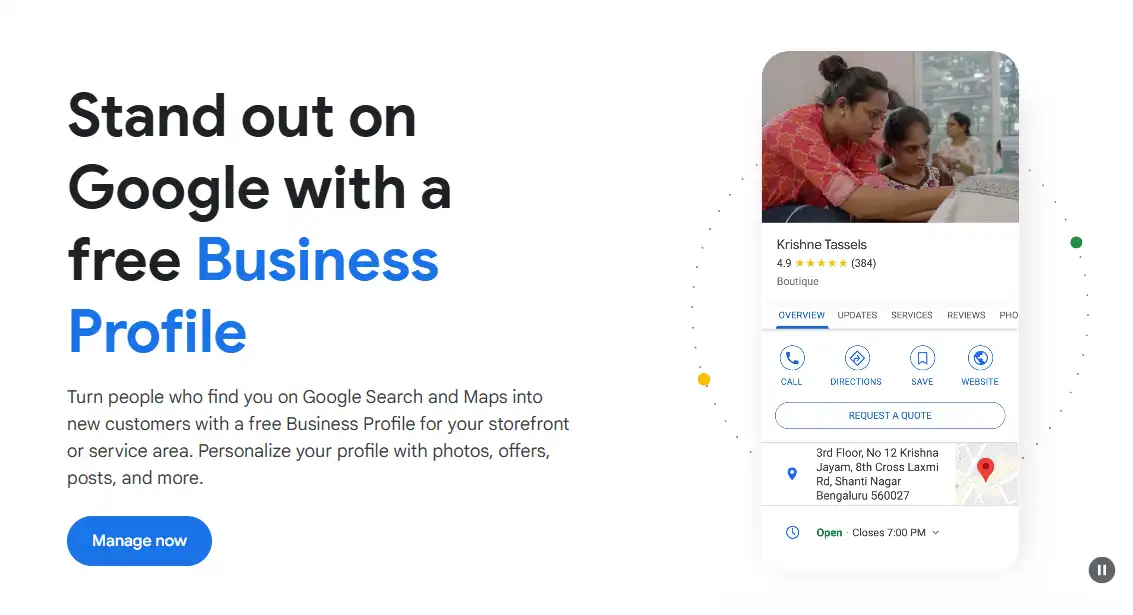Table of Contents[Hide][Show]
Top 10 Local SEO Strategies for Small Businesses+−
- 1. Optimize Your Google My Business Profile
- 2. Use Local Keywords to Power Your Content
- 3. Encourage and Manage Online Reviews
- 4. Make Your Website Mobile-Friendly
- 5. Use Schema Markup
- 6. Build Local Links
- 7. Engage on Social Media
- 8. Optimize for Voice Search
- 9. Get Listed in Local Directories
- 10. Monitor and Adapt
- Wrapping It Up
Running a small business is challenging, especially when you’re competing with larger companies for online visibility. But here’s the good news: local SEO strategies for small businesses can help you attract more local customers and boost your visibility, even if you have a limited marketing budget. The numbers speak for themselves:
- 46% of all Google searches are looking for local information. (Source: GoGulf)
- 76% of people who search for something nearby on their smartphone visit a business within a day. (Source: Google)
- Businesses that appear in Google’s local 3-pack get 700% more clicks than those outside of it. (Source: Moz)
If you’re ready to rise above the competition, let’s dive into 10 proven local SEO strategies for small businesses to help your small business succeed in 2025.
Top 10 Local SEO Strategies for Small Businesses
1. Optimize Your Google My Business Profile

Your Google My Business (GMB) profile is critical—it’s where most local customers will first encounter your business. Did you know that 64% of consumers use GMB to find contact details or operating hours?
To make the most of GMB:
- Add accurate business details (name, address, phone number, website).
- Upload photos that showcase your business.
- Regularly update your hours, especially during holidays.
- Encourage customers to leave reviews.
Businesses with at least 10 reviews and an average rating of 4 stars or higher tend to rank higher in local search results. This is undoubtedly one of the most crucial local SEO strategies for small businesses.
Pro Tip: Make it a habit to respond to reviews—both positive and negative. Engaging with customers shows you care and can further strengthen your reputation.
2. Use Local Keywords to Power Your Content
If you’re not tailoring your website content to your local audience, you’re missing out. Do some keyword research to discover the terms people in your area are searching for, then integrate those keywords into your website’s titles, meta descriptions, headings, and content.
If your website isn’t optimized with local keywords, you’re missing a huge opportunity. Research shows that 76% of local searches result in a phone call, visit, or purchase within 24 hours.
Here’s how to do it:
- Use tools like Google Keyword Planner to find local search terms.
- Include location-specific keywords naturally in your titles, headings, meta descriptions, and website content.
- Create dedicated landing pages for each city or region you serve.
For example, if you’re a bakery in Austin, phrases like “best cupcakes in Austin” or “Austin custom cakes” should naturally appear in your content. Consider creating dedicated landing pages for specific locations or services to make your site even more relevant to local searches.
3. Encourage and Manage Online Reviews
Let’s face it—online reviews are powerful. They shape how potential customers view your business and play a big role in local SEO rankings.
A staggering 93% of consumers say online reviews influence their purchasing decisions. Businesses with more reviews and higher ratings typically outrank their competitors in local searches.
Platforms like Google, Yelp, and TripAdvisor matter. To maximize reviews:
- Ask happy customers to leave a review right after their purchase.
- Respond to every review—positive or negative.
But don’t stop there—make sure you actively manage your reviews by responding to feedback (even negative ones). Showing that you care about customer experiences helps build trust and signals to search engines that your business is legitimate and customer-focused.
Data shows that businesses that actively manage their reviews see up to 20% more conversions.
4. Make Your Website Mobile-Friendly
More than 60% of Google searches are conducted on mobile devices, and 88% of consumers who search for a local business on their phone either call or visit within 24 hours.
Here’s how to ensure your site is mobile-friendly:
- Use a responsive design so your site looks good on all devices.
- Ensure fast load times—40% of people leave a site if it takes more than 3 seconds to load.
- Optimize for easy navigation with mobile users in mind.
A mobile-friendly website can increase your chances of converting visitors into customers by up to 67%. This is by far one of the most important local SEO strategies for small businesses.
5. Use Schema Markup
Schema markup might sound technical, but it’s essentially a type of code that helps search engines understand your website better. For small businesses, it’s a game-changer.
Websites with schema markup get 20-30% higher click-through rates compared to those without it.
Focus on adding schema for:
- Business hours
- Address and phone number
- Customer reviews
This is one of the most underrated local SEO strategies for small businesses. But, by implementing schema, your business is more likely to appear in Google’s local rich snippets, which can significantly increase visibility.
6. Build Local Links
Local backlinks are one of the most effective ways to improve your local SEO rankings. Studies show that backlinks are a top-ranking factor, accounting for 28% of Google’s local search ranking signals.
Here’s how to build local links:
- Partner with local businesses or organizations.
- Sponsor community events or charities.
- Get listed in local online directories.
For example, a local bakery might collaborate with a nearby coffee shop to cross-promote each other’s services.
7. Engage on Social Media
Social media isn’t just for fun—it’s a powerful tool for local SEO. 78% of local searches on mobile devices result in offline purchases, and social media can drive that traffic to your business.
Tips for social media engagement:
- Share posts about local events or promotions.
- Use location tags to increase discoverability.
- Encourage user-generated content—like photos of customers using your products.
Social platforms like Facebook and Instagram are great for fostering community loyalty and brand awareness.
8. Optimize for Voice Search
With 71% of consumers preferring voice searches over typing, optimizing for this technology is more important than ever. Most voice searches are phrased as questions, so your content should focus on long-tail keywords and conversational phrasing.
For example:
- Instead of “plumber near me,” focus on “Who offers 24-hour plumbing services near me?”
- Provide clear and concise answers to common customer queries on your site.
Voice search optimization can drive up to 20% more traffic to local businesses.
9. Get Listed in Local Directories
Local business directories drive significant traffic and enhance your SEO. Businesses that are listed in directories see an average of 50% more local search visibility.
To get started:
- Claim your listing on directories like Yelp, Yellow Pages, and TripAdvisor.
- Ensure your NAP (Name, Address, Phone Number) is consistent across all listings.
Consistency improves your chances of ranking higher in local search results.
10. Monitor and Adapt
The digital landscape is always changing, so staying on top of your strategy is critical. According to research, companies that adapt their SEO strategies at least once a year are 2x more likely to achieve top rankings.
Regularly check these metrics:
- Search rankings
- Website traffic
- Conversion rates
Be prepared to adjust your strategy based on algorithm updates and emerging trends.
Wrapping It Up
Mastering local SEO strategies for small businesses isn’t just about getting to the top of search results—it’s about building real connections with your community and staying relevant in a competitive digital world.
By implementing the 10 strategies outlined here, you’ll be well on your way to increasing visibility, gaining more customers, and growing your business.
What results have you seen from your local SEO efforts? Share your challenges and successes in the comments below—we’d love to hear your story!


 SEO in 2025: Trends to Expect in the Future
SEO in 2025: Trends to Expect in the Future
Leave a Reply